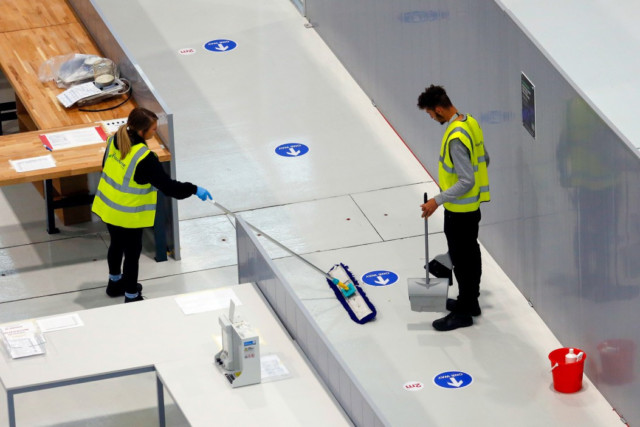MINISTERS have revealed a fresh five-step plan to try and keep all workplaces safe from coronavirus tonight.
New ‘COVID-19 secure’ guidelines are now available to UK employers to help them get their businesses back up and running and workplaces operating as safely as possible.
Every workplace with more than five people in it will have to do a coronavirus health and safety audit
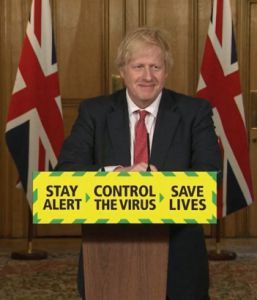
Boris wants more people to start going back to work if they can’t do their jobs from home
Brits are facing massive changes when they go back to work as employers are urged to minimise the risk of a second peak.
Boris Johnson said yesterday he wants more people to start going back to work if they can’t do their jobs from home.
In heaps of paperwork published online on the Goverment website this evening, ministers put out eight documents for firms from offices to takeaways to follow to stop their employees spreading the bug to others.
Every workplace with more than five people in it will have to do a coronavirus health and safety audit.
And they will be urged to speak with their staff and unions to make sure they feel safe in their workplace, too.
Companies will be expected to use floor tape to help staff maintain two metres apart, put screens between people, and provide packaged meals to avoid opening staff canteens.
Hotels and Restaurants will be asked to keep bar areas closed, and continue to only do takeaways, and also ask customers to wait outside for their meals.
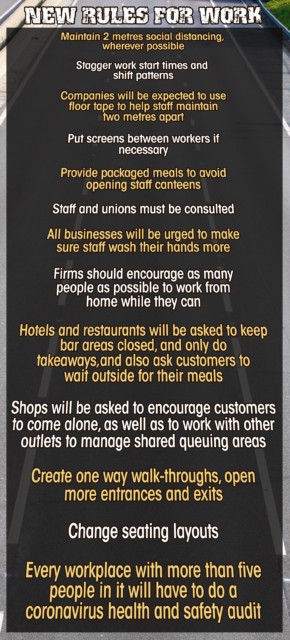
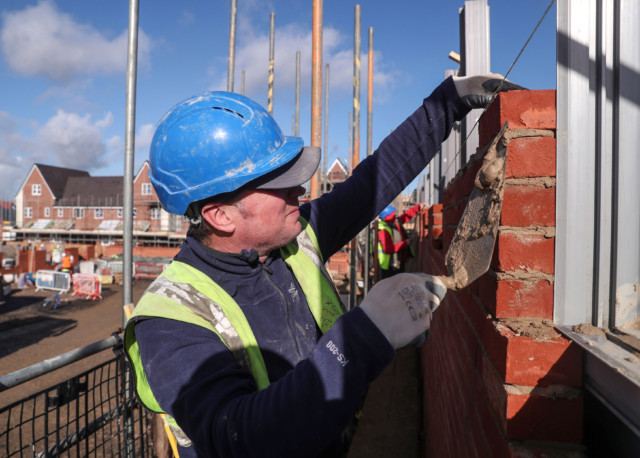
New rules to get back to work have been issued to businesses tonight
Shops will be asked to encourage customers to come alone, as well as to work with other outlets to manage shared queuing areas.
All businesses will be urged to make sure staff wash their hands more, and surfaces get extra cleaning.
Firms should encourage as many people as possible to work from home while they can.
If they can’t, they should carefully consider whether the tasks should go ahead as planned.
“No one is obliged to work in an unsafe work environment,” the documents state.
When employees can’t safely stay two metres apart to work they should consider using shields, limiting the time doing work, work side to side or back to back instead, or work in fixed teams to limit their contact with others.
They can also consider wearing masks to carry out their work.

Boris has urged people who can to go back to work
Offices
- Stagger work shifts to have fewer people in the office at once
- Providing handwashing facilities, or hand sanitiser where not possible, at entry and exit points
- Have limits on the number of people in rooms and lifts
- Move work stations further apart
- Use screens to keep desks and people separate
- Use remote working tools to avoid in-person meetings
- Don’t share pens or other objects
- Hold meetings in well ventilated rooms
- Stagger breaks to reduce pressure on rooms or areas to eat
- Opening windows and doors frequently to encourage ventilation, where possible
- Providing packaged meals or similar to avoid opening staff canteens, where possible
- Encouraging workers to bring their own food
Restaurants (take away and delivery)
- Putting teams into shifts to restrict the number of workers interacting with each other
- All food and drink outlets should be takeaway only
- Encourage contactless payments where possible
- Staggering arrival and departure times at work to reduce crowding into and out of the workplace
- Requesting staff change into work uniforms on site using appropriate facilities/changing areas
- Reducing job and location rotation, for example, assigning workers to specific floors or keeping temporary personnel dedicated to one site
- Allowing kitchen access to as few people as possible
- Minimising contact at ‘handover’ points with other staff, such as when presenting food to serving staff and delivery drivers
Shops
- Use markings to guide staff coming into or leaving the building – and open more doors to get people in and out
- Use tape to show people how far away to be from each other
- Customer services may need to be ditched if they can’t be safe
- Shoppers should be encouraged to come alone, and there should be a limit on the number of people inside a shop
Factories and warehouses
- Reducing job and equipment rotation
- Regulating use of high traffic areas including corridors, lifts, turnstiles and walkways to maintain social-distancing
- Using protective screening for staff in receptions or similar areas
- Encouraging staff to stay on-site during working hours
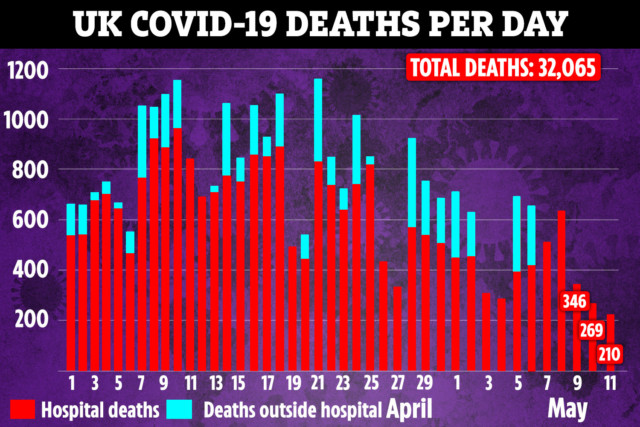
Construction and other outdoor work
- Limiting passengers in corporate vehicles, for example, work minibuses
- Reducing movement by discouraging non-essential trips within buildings and sites
- Separating sites into working zones to keep different groups of workers physically separated as much as practical
- Using a consistent pairing system if people have to work in close proximity, for example, during two-person working, lifting or maintenance activities
- Using safe outdoor areas for breaks
Vehicles
- Assigning fixed groups of workers to the same transportation routes where sole travel is not possible
- Finding alternative solutions to 2-person delivery. This could include delaying delivery of large items or using an alternative method, for example, mechanical / material handling equipment
- Picking goods ahead of collection and loading onto vehicles without interacting with the driver
- Scheduling times for the collection of goods to avoid over-crowding
- Making sure vehicles are well-ventilated to increase the flow of air, for example, by opening a window
- Ensure regular cleaning of vehicles, in particular between different users
Homes
- Consider travelling to sites alone using your own transport
- Asking that households leave all internal doors open to minimise contact with door handles
- Bringing your own food and drink to households and having breaks outside where possible
- Only absolutely necessary participants should attend appointments and should maintain 2m separation where possible
- Allocating the same workers to a household where jobs are repetitive
- Using remote working tools to avoid in-person appointments
Labs and research facilities
- Washing lab clothing and equipment such as goggles and gloves on-site rather than by individual staff members at home
- Removing access controls on low category labs so that people do not have to use access cards
- Using fixed teams or adjusting booking processes to reduce the number of people in a lab at the same time to avoid overcrowding
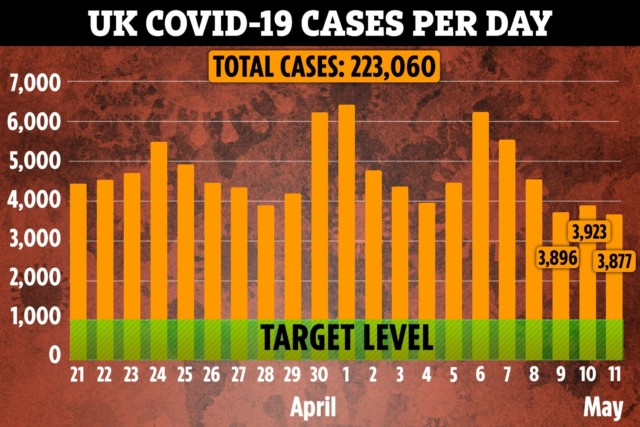
The documents are released after consultation with Public Health England and the Health and Safety Executive.
An extra £14million in funding will be given to Health and Safety bosses for extra staff, call centre employees, to carry out spot inspections and check that firms are following the rules.
They could face fines if they refuse to comply.
There’s no specific date for when the measures should be put in place, only as soon as it’s practically possible to do so.
The guidance is currently only for workplaces that are open or partially open, but more will come in the next few days.
On Monday afternoon Boris Johnson told Parliament the Health and Safety Executive will enforce good practice with spot inspections carried out to safeguard returning staff during the Covid-19 crisis.
The PM told the Commons: “We are going to insist that businesses are going to look after their workers. We will be having spot inspections to make sure businesses are keeping employees safe.”
And Business Secretary Alok Sharma later said: “This guidance provides a framework to get the UK back to work in a way that is safe for everyone. These are practical steps to enable employers to identify risks that COVID-19 creates and to take pragmatic measures to mitigate them.
“And as we are able to reopen new sectors of the economy, we will continue our collaborative approach working with a wide range of stakeholders, to provide guidance for additional workplaces.”


